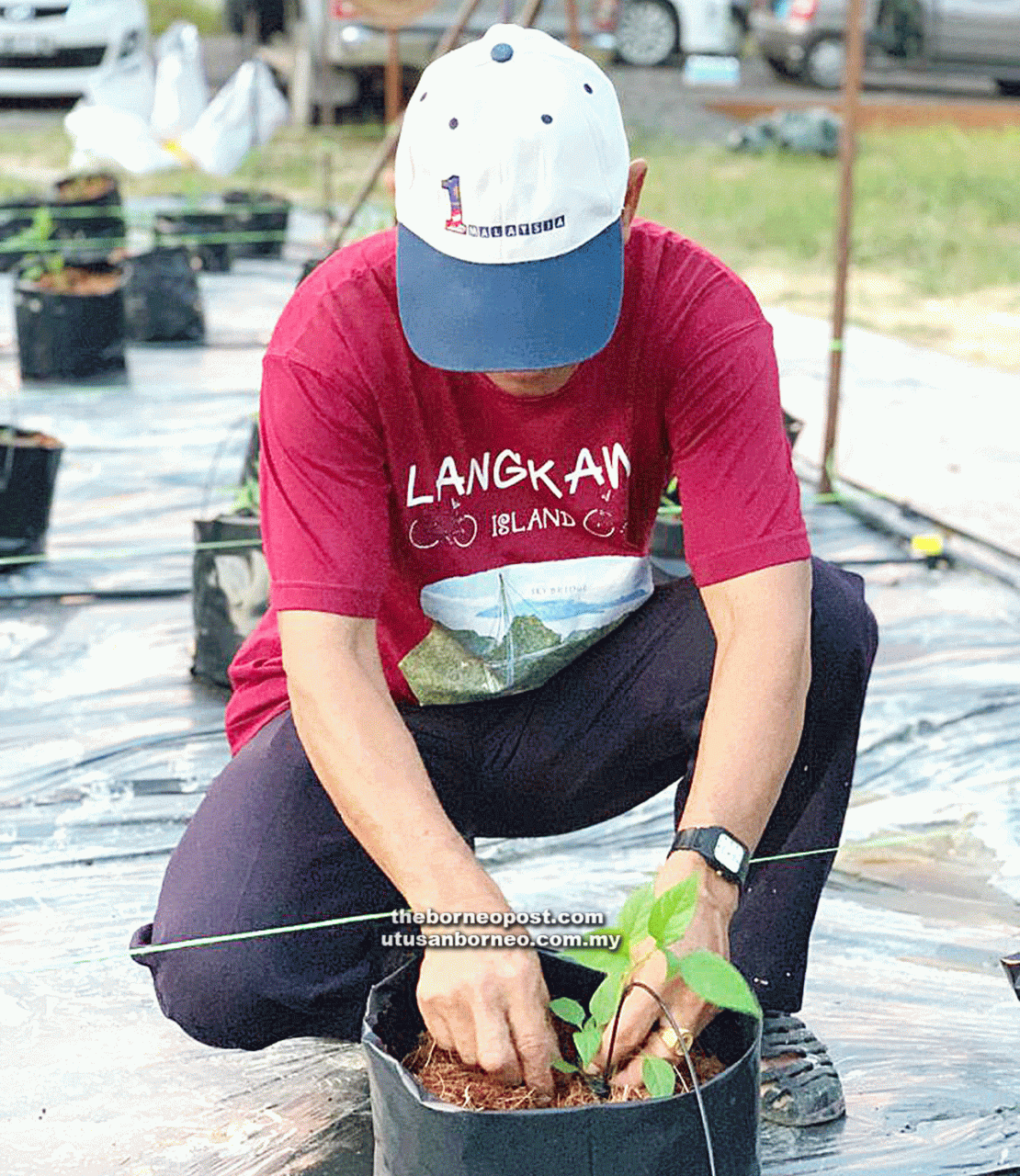
Farming chilli padi with fertigation system for better yields.
THE trip to 17-door Rumah Eddy Jemat in Kemuyang was both educational and eye-opening.
Located about 20 minutes’ drive from Sibu town, it’s one of 34 longhouses in Nangka constituency where one can experience the local culture and scenic surroundings.
However, a closer look revealed the presence of hundreds of black polybags – 500 to be exact – neatly arranged over a 65 square metre site, about 200 metres from the longhouse.

Dr Annuar Rapaee
Pilot project
Assistant Minister of Education and Technological Research Dr Annuar Rapaee told thesundaypost the polybags are for a pilot project to plant chilli padi (bird’s eye chilli) with the fertigation system.
Dr Annuar, who is Nangka assemblyman, said the trial was now underway at two locations – Rumah Eddy Jemat and Kampung Datu Baru – in the Nangka constituency.
He initiated the pilot project in February this year, saying it would run for three years and for 2019, 10 more locations in the area were being targeted for planting.
Longhouse chief Eddy Jemat said the longhouse residents were delighted with the pilot project and he has assured their commitment to make the project a success.
“We’re all very excited as chilli padi is a cash crop fetching a good price in the market. I was told by Dr Annuar when the pilot project starts bearing fruit, it will be implemented at other longhouses or other locations in Nangka.”
He noted that most people included chilli in their diet and for them, meals would not be complete without a serving of spicy dishes.
“So, there is good demand for this crop,” he added.

Chilli padi seedlings are grown in polybags for the pilot project.
Chilli farming
According to Wikipedia, bird’s eye chilli, piri piri, or Thai chilli is a chili pepper which is a variety of the Capsicum annuum species, commonly found in Ethiopia and across Southeast Asia.
It is used extensively in Thai, Malaysian, Singaporean, Lao, Khmer, Indonesian, and Vietnamese cuisines.
There are two ways to cultivate chilli – by using the conventional method and the fertigation system.

The 17-door Rumah Eddy Jemat in Kemuyang.
Boosting rural economy
Dr Annuar explained he opted for chilli padi because it’s currently in demand and the longhouse folks could make a good income from it.
He said chilli padi is a very hardy plant that does not require nettings, adding that the soil at the two trial locations is suitable and harvesting could be done in three months.
“In the future, chilli padi can even be supplied to vegetable markets, restaurants and hotels across Sarawak. This will definitely help boost the income of the rural folk.”
Eddy concurred with Dr Annuar that the project, if proven successful, would help improve the socioeconomic situation of the longhouse residents.
“I have been made to understand 1kg of chilli padi can now fetch about RM25 in the market,” he said.

The digital timer used in the fertigation system.
Big potential
Chilli is of the same family as tomatoes and potatoes and grown for their fruits.
According to a baseline report on chilli production practices in Central Java, Indonesia, chilli is an important cash crop in the archipelago which boasted the largest crop acreage for all vegetables of over 200,000 ha in 2007.
Indonesia reportedly accounts for about 5 per cent of global annual chilli production with over 85 per cent of total national chilli production occurring in Java and Sumatra, the two largest Indonesian islands.
Fertigation technology
According to Dr Annuar, the services of a private company – GP Enterprise – were engaged for the project.
Mohammad Fadzli Jawawi and Abang Ismail Abang Chek from the company are teaching the longhouse residents how to use the fertigation system, which also serves as an alternative prevention against soil-borne diseases.
Eddy said farming chilli using the traditional method was quite labour-intensive whereas the fertigation system not only lessens the intensiveness but also improves yields.

Workers install electrical wires for the fertigation digital timer.
Giving some insights into the fertigation system, he said a digital timer could be set to regulate the supply of water and fertilisers from the tank to the plants.
“The process is repeated six times a day and the fertilisers are applied with irrigation water. Pesticides are used once a week. The polybags are left out in the open and there is no need for rain shelter.
“We are still learning how to use this system and are very thankful to Dr Annuar for the pilot project at our longhouse.
“Indeed, when the project is brought to fruition, the longhouse residents can expect better income from chilli padi farming.”
Eddy pointed out that the fertigation system is the way forward in chilli farming.
Based on the Malaysian Agricultural Research and Development Institute (Mardi) blog, fertigation is an agricultural technique that maximises crop yields through controlled application of water and fertilisers.
Through this application, the negative effects of fertilisers leaching to the roots, soil and groundwater can be avoided. According to the Mardi blog, fertigation of vegetables such as chili, cucumbers, tomatoes, and high-valued fruits such as rock melons is widely practised in Malaysia.
Crop yields of up to five times per unit area have been achieved and this has contributed to the system’s increasing public interest and appeal.
Planting chilli using fertigation technology is also becoming the choice of entrepreneurs.
Given the good future of farming in his constituency, Dr Annuar wants his service centre to double as a training centre for fertigation farming and he encourages youths to take up farming as a career.
